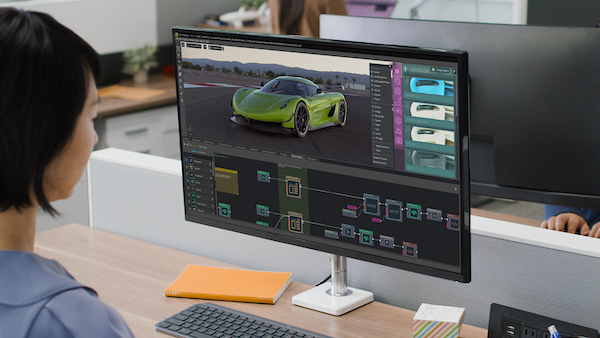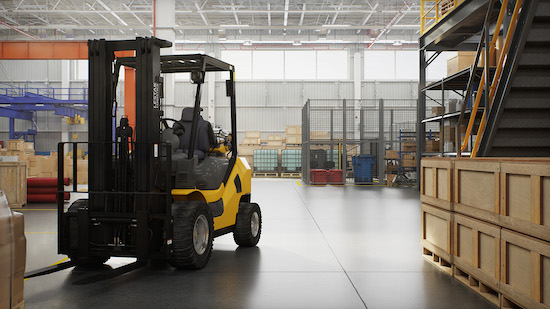
NVIDIA’s partners are developing automotive configurators powered by NVIDIA Omniverse™. Image courtesy of NVIDIA.
Latest News
January 15, 2024
At this year’s International CES (Consumer Electronics Show, Las Vegas, Nevada, Jan. 9-12), NVIDIA made a special address, highlighting technology that the company says will usher in a new wave of AI-ready hardware and applications.
“Today, NVIDIA is at the center of the latest technology transformation: generative AI,” said Jeff Fisher, senior VP for GeForce, NVIDIA. “NVIDIA’s RTX™ GPUs, with more than 100 million units shipped, are pivotal in the burgeoning field of generative AI, exemplified by innovations like ChatGPT and Stable Diffusion.”
While CES caters to the consumer crowd, NVIDIA’s consumer-targeted initiatives are often precursors to what’s coming down the pike in the professional portfolios.
The company points out, “Mobile workstations with RTX GPUs can run NVIDIA AI Enterprise software, including NVIDIA TensorRT™ and NVIDIA RAPIDS™ for simplified, secure generative AI and data science development. A three-year license for NVIDIA AI Enterprise is included with every NVIDIA A800 40GB Active GPU, providing an ideal workstation development platform for AI and data science.”
AI’s Impact on Robotics
One area where NVIDIA expects AI-powered natural language processing to accelerate developments is in the field of robotics. Deepu Talla, VP of Robotics and Edge Computing, NVIDIA, believes the tipping point for a robotic transformation is coming soon.
He said, “Generative AI models achieve higher accuracy while generalizing rather well. And applications are built using natural language prompts or texts. Given these attributes, generative AI is well-suited for robotics.” The same AI model, he added, could also help generate synthetic data to augment the collected data.
NVIDIA’s platform for training and developing autonomous robots is NVIDIA Isaac Sim™, a robotic simulation platform. For robotic training, in addition to the model of the robot itself, users usually need to create a replica of the environment where the robot operates, such as warehouses and factory floors. The use of natural language is already starting to transform how users create and populate these dynamic environments.
Talla said, “Starting with NVIDIA PICASSO, you can use a text-to-object generative AI model to generate new assets and place them in the scene. With a text prompt, generative AI can add rain, water, rust, and more to existing environments. Tasks that typically take an artist days, can be completed in minutes.”

Cobots and robots performing tasks alongside human operators are expected to meet regulatory requirements, which set the safety protocols: for example, the speed and velocity with which they move. Gerard Andrews, Senior Product Manager for Robotics, NVIDIA, said, “We have active engagement with a number of regulatory bodies. We look at proactive safety, reactive safety, and predictive safety. We are participating in efforts to drive the three concepts and are pushing for a number of safety standards.”
Omniverse-Powered Car Configurators
NVIDIA is also promoting its immersive 3D simulation platform NVIDIA Omniverse™ to automakers at CES. This time, the attraction is the Omniverse-powered car configurators, developed and marketed by BITONE, Brickland, Configit, Katana Studio Ltd., WPP, ZeroLight, and other partners.
“OEMs benefit from a unified asset pipeline that simplifies the integration of design and engineering data for marketing purposes. Omniverse’s enhanced tools also allow them to quickly produce diverse marketing materials, boosting customer engagement through customized content,” NVIDIA points out in its announcement. When running on NVIDIA Graphics Delivery Network, the automotive configurators can be easily published at scale and streamed to most devices around the world.”
(You can read more about one of these configurator applications in our previous coverage here.)
NVIDIA also spotlighted in particular Mercedes-Benz, Polestar, Kodiak, and Pebble as automakers who have infused AI-powered features in their vehicle lines and are showcasing them at the conference.
“Mercedes-Benz is also using digital twins for production with help from NVIDIA Omniverse, a platform for developing applications to design, collaborate, plan and operate manufacturing and assembly facilities … Kodiak is exhibiting an autonomous truck, which relies on NVIDIA RTX GPUs for high-performance compute to process the enormous quantities of data it collects from its cameras, radar and lidar sensors,” NVIDIA announced.
In a briefing with the industry press, Danny Shapiro, VP of Automotive, NVIDIA, said, “With Omniverse-powered configurators, consumers can experience the car exactly as they want . They can customize the leather, the trim, the wheels, and then take the car out for a virtual test drive. For developers, they can even simulate the software that runs inside the car.”
You can learn more in blogs that NVIDIA published during CES about its robotics and automotive capabilities.
More Dell Coverage

More NVIDIA Coverage
Subscribe to our FREE magazine, FREE email newsletters or both!
Latest News








